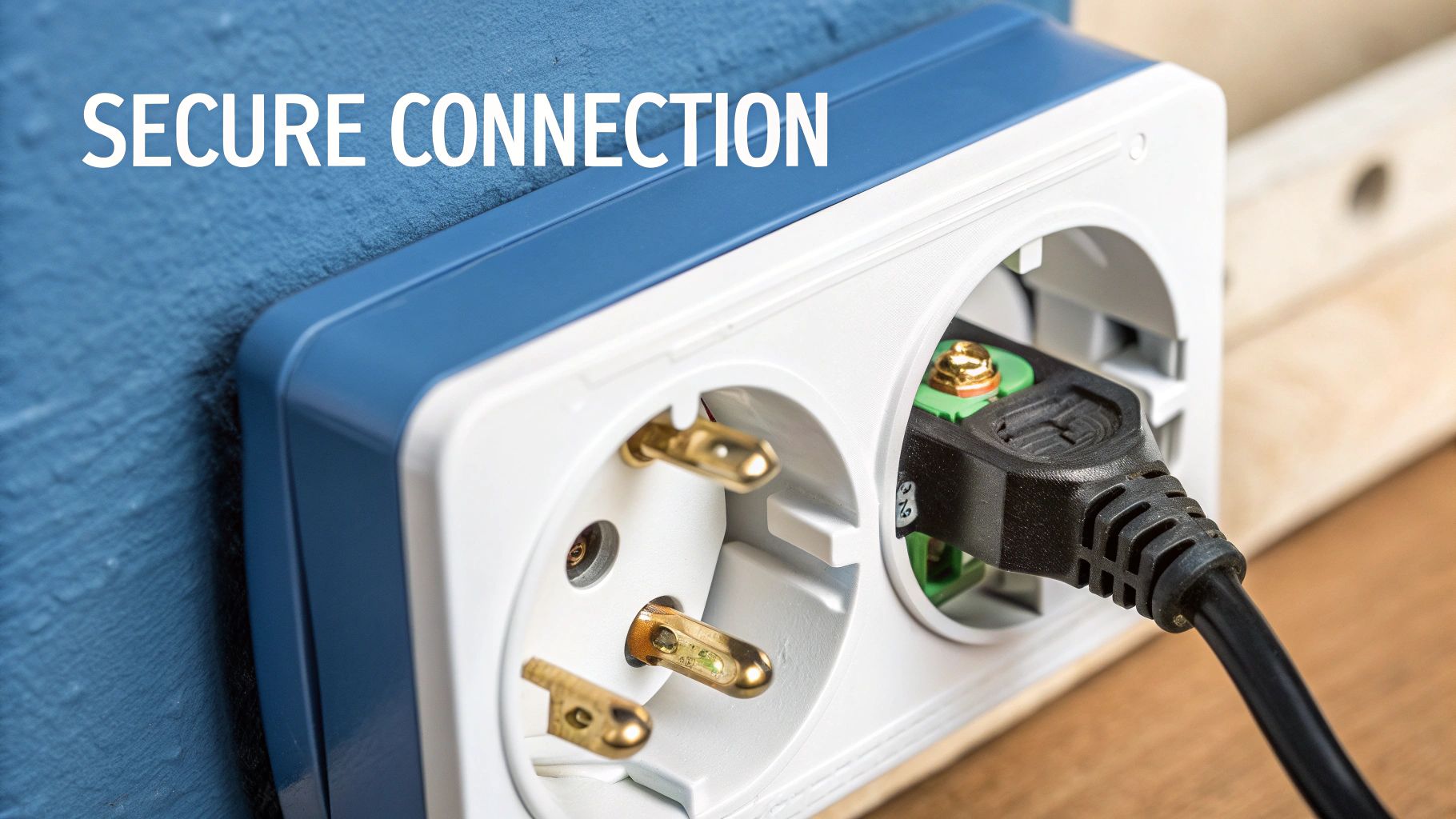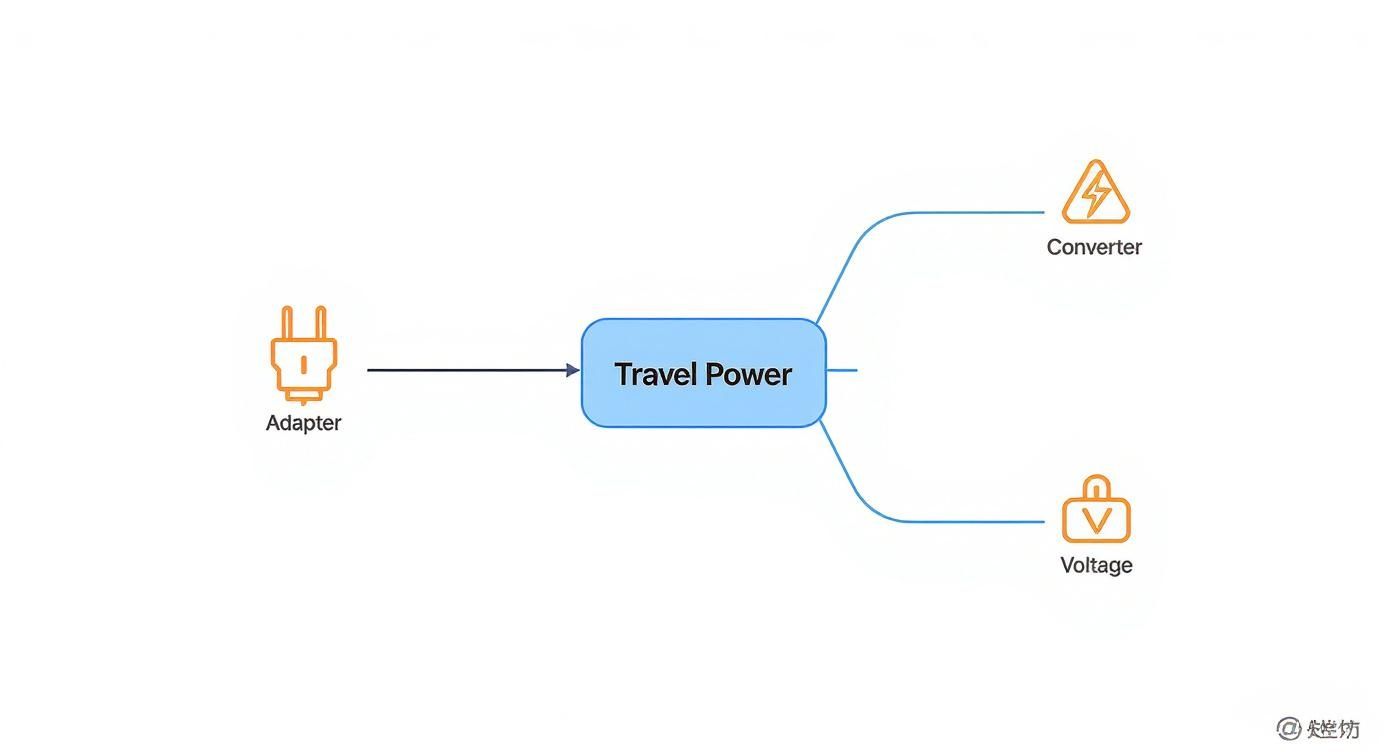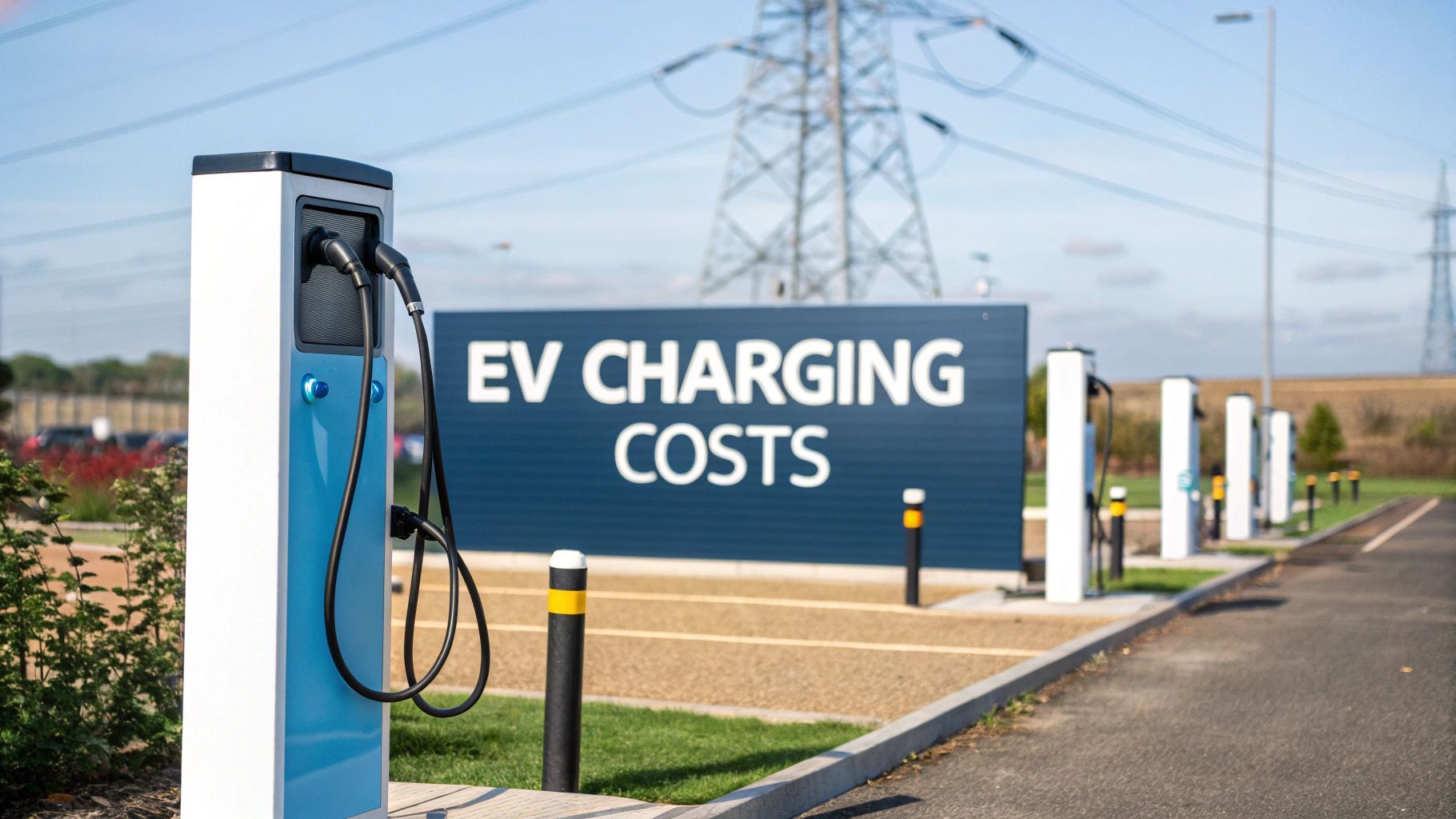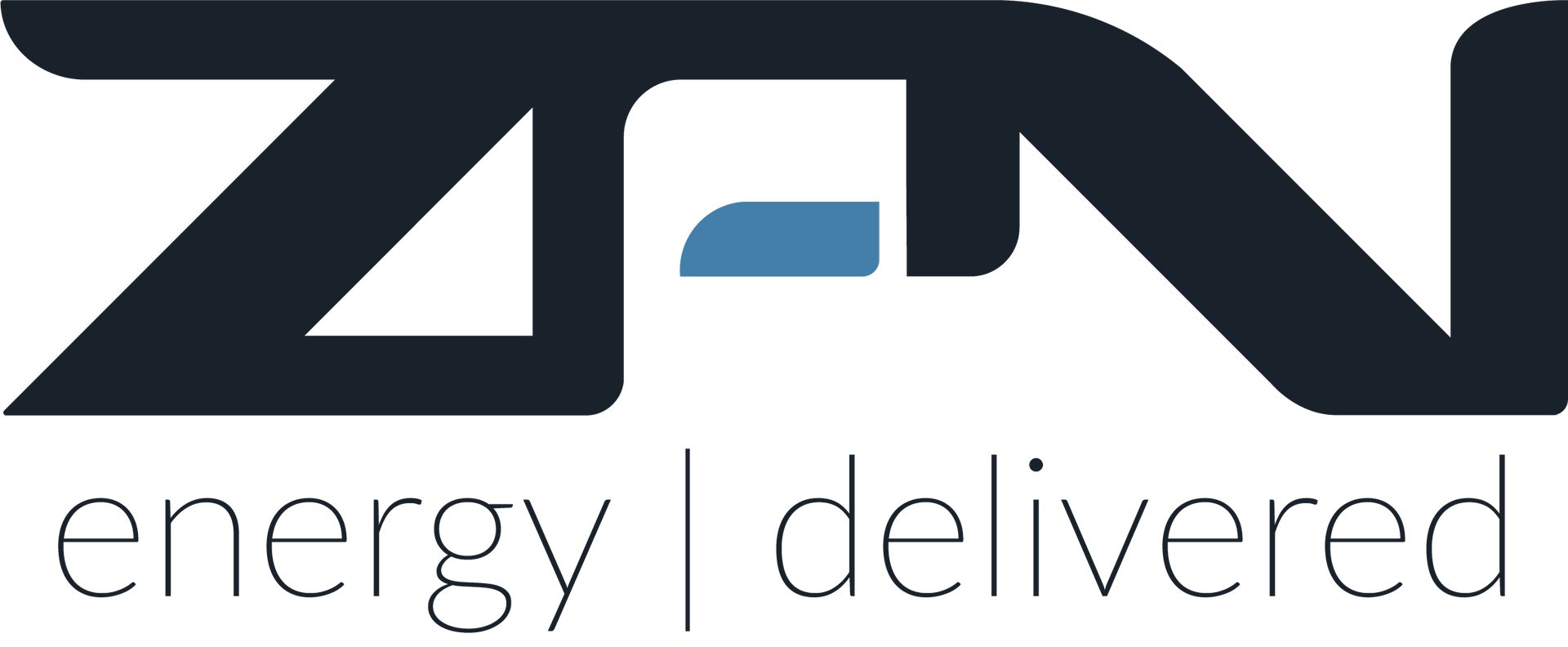A Traveller's Guide to Power Plugs in Korea
Before you jet off to South Korea, there's one small but crucial detail you'll need to sort out: how to keep your devices charged. The country runs on Type F power plugs and sockets , sometimes known as the "Schuko" plug, which operate at a standard 220V with a frequency of 60Hz . That's a different setup from what we're used to in the UK, so a little prep goes a long way.
Your Essential Guide to Korean Power Sockets

Getting to grips with the local electrical standards is key to a smooth trip. In South Korea, you'll find Type F sockets pretty much everywhere. You can spot them easily: they have two round pinholes, plus grounding clips at the top and bottom for a secure fit.
If you're travelling from the UK with our chunky, three-pronged Type G plugs, a travel adapter is an absolute must-have for your suitcase. The good news is that most modern gadgets like laptops and phone chargers are designed to handle a wide voltage range, so you’ll almost certainly just need a simple plug adapter rather than a heavy, expensive voltage converter.
Key Electrical Standards in Korea
It's always a smart move to glance at the power label on your device before plugging it in, just to be safe. Here’s a quick rundown of what you’ll be working with:
- Plug Type: Type F (the Schuko plug with two 4.8mm round pins).
- Socket Compatibility: Also accepts the common two-pin Type C "Europlug" .
- Voltage: The standard is 220V .
- Frequency: The standard is 60Hz .
For a quick reference you can keep handy, here's a table summarising the key specs.
South Korea's Electrical Standards at a Glance
This table provides a quick summary of the key electrical specifications for travellers visiting South Korea.
| Attribute | Specification | Note for Travellers |
|---|---|---|
| Plug Type | Type F | Also known as the "Schuko" plug. |
| Compatible Plugs | Type C & Type F | The two-pin Type C "Europlug" fits without an adapter. |
| Voltage | 220V | Check your device supports this; most modern electronics do. |
| Frequency | 60Hz | Most devices are compatible, but check sensitive equipment. |
These details are more than just trivia for tourists; they're the bedrock of the country's entire energy infrastructure. This includes the rapidly expanding network of electric vehicle charging points. While EV charging plugs have their own specific designs, the fundamental principles of voltage and compatibility are just as vital, especially when considering solutions for EV charging from constrained grid connections . To see how another nation is tackling its grid for EV growth, our guide to electric plugs in Chile for EV charging provides an interesting point of comparison.
Here's a handy tip for European travellers: the ubiquitous Type C plug, commonly found on phone chargers and other small devices, fits perfectly into South Korea's Type F sockets. No adapter needed for those.
Understanding the Type F Plug Design

This recessed shape works perfectly with the plug's two chunky, 4.8 mm round pins . Think of it like a key sliding snugly into its lock. The combination of the snug pin fit and the recessed socket makes for a far more reliable connection, cutting down the risk of intermittent power or sparks from a plug that's halfway out.
The Role of Grounding Clips
Safety is built right into the core of the Type F plug's design. Look closely inside the socket and you'll spot two spring-loaded clips, one at the top and one at the bottom of the inner rim. These are the grounding contacts.
When you insert a Type F plug, these clips make firm contact with conductive strips running along the plug's side. This connection provides an essential safety earth, protecting both you and your electronics from electrical faults. It's a beautifully simple but highly effective system for preventing nasty electric shocks.
For many European travellers, there's a welcome surprise. The smaller, two-pin Type C plug, commonly found on phone chargers and other small electronics, is fully compatible with Type F sockets. You can plug it directly into the wall without needing any adapter.
Compatibility with the Type C Europlug
This cross-compatibility is a huge convenience for travellers. The Type F socket was intentionally designed to also accept the thinner pins and ungrounded format of the Type C "Europlug" . So if you're travelling with a device that has this common European plug, you won't need to pack an adapter for it.
This level of thoughtful design is critical not just for personal electronics but for larger infrastructure, too. The same principles of secure connections and safety grounding are scaled up in systems for rapid EV charging . Ensuring a stable connection is absolutely vital when dealing with the high power needed for mobile EV charging , where a poor connection could have serious consequences, especially when operating from constrained grid connections .
Why Voltage and Frequency Really Matter
Getting the plug shape right is only half the battle. Making sure your device can handle the local electrical current is just as crucial. Trying to run an appliance on the wrong voltage is a bit like putting diesel in a petrol car—it can cause serious, sometimes permanent, damage.
South Korea’s national standard is 220 volts (V) , which is a significant jump from the 110-120V used across North America.
Luckily, most modern electronics are built for global travel. Before you start worrying, take a look at the power brick or the small print on your device. You're searching for a vital piece of information that reads something like 'INPUT: 100-240V' .
If you see that text, your device is dual-voltage . This means it’s smart enough to automatically adapt to different voltages around the world. Gadgets like laptops, phone chargers, and camera battery chargers nearly always have this feature, so all you'll need is a simple plug adapter to connect them.
The Role of Frequency
You'll also spot another number on that label: frequency, measured in Hertz (Hz). South Korea operates at 60Hz . While this is different from the UK’s 50Hz standard, most modern electronics are completely unfazed by it. The '100-240V' label is often paired with '50/60Hz', confirming it will work fine on either frequency.
However, older or simpler appliances with motors—think some electric clocks or shavers—might behave a little differently. A device designed only for 50Hz could run slightly faster or get hotter on a 60Hz system. It’s rarely an issue for a short trip, but it's something to be aware of if you're travelling with sensitive equipment.
The key takeaway is this: always check the 'INPUT' label on your electronics. If it reads '100-240V, 50/60Hz', you are perfectly safe to use it in South Korea with only a plug adapter. If it only shows a single voltage like '120V', do not plug it in without a voltage converter.
These principles of matching voltage are universal, whether you're dealing with personal devices or large-scale electrical grids. They're also fundamental when planning for different electrical systems, a topic we explore further in our guide to voltage for Mexico and EV charging.
Choosing the Right Travel Adapter for Korea
Figuring out travel gadgets can sometimes feel like a puzzle, but for South Korea, it's actually pretty straightforward. The main thing to get your head around is the difference between a simple plug adapter and a much bulkier voltage converter. An adapter just changes the shape of the prongs to fit the wall socket, whereas a converter actually changes the electrical voltage.
For most of us travelling with modern electronics like phones, tablets, and laptops, a simple Type F plug adapter is all you'll need. These devices are already built to handle the 220V supply you'll find in Korea, no problem. You'd only need to think about a converter if you're packing much older, single-voltage items that aren't designed for 220V .
What to Look For in an Adapter
When you're picking out an adapter, don't just grab the cheapest one. It's worth looking for something that prioritises safety and is built to last. Check for safety certifications like CE or BS markings, which are good indicators that they meet high safety standards. A solid build quality means it won't fall apart in your bag after one trip.
Investing in a universal travel adapter can be a smart move, setting you up not just for Korea but for future adventures too. Many of the newer ones come with multiple USB ports built-in, which is a lifesaver for charging several devices from a single wall socket. This is especially handy in hotel rooms where you might only find one or two available outlets.
A question that often comes up is whether to buy an adapter before you go or when you land. For total peace of mind, it’s always best to have one packed in your bag before you leave home. But if you do forget, don't panic—they're easy to find at Incheon Airport and in local convenience stores like CU or GS25.
Getting to grips with different regional power systems is fascinating, not just for your own travels but for understanding global energy infrastructure. If you're curious about how another country handles its electrical standards, our guide to the electric plug Tanzania uses offers an interesting comparison.
Powering Electric Vehicles Across South Korea
The conversation around power plugs in South Korea is growing beyond personal electronics to encompass the entire transport sector. The country has proactively standardised its EV charging infrastructure to support the rising number of electric vehicles on its roads, focusing on smart solutions that address grid limitations.
For rapid EV charging on the move, the CCS Combo 1 connector is the dominant standard for DC power. For slower AC charging, typically done overnight at home or hotels, the Type 1 (J1772) connector is prevalent. This dual-standard approach ensures comprehensive coverage. And for those thinking long-term, it's also worth looking into the costs associated with installing a home EV charger for ultimate convenience.
This infographic breaks down the difference between the simple adapters you'd use for your travel gadgets and the more complex converters needed for certain appliances.

As you can see, an adapter just changes the physical shape of the plug, whereas a converter is essential if you need to change the actual electrical voltage.
Smart Solutions for a Strained Grid
The simultaneous charging of thousands of EVs places an enormous demand on the national power grid, particularly in areas with constrained grid connections . To mitigate this, South Korea is implementing sophisticated strategies centred on distributed energy and smart grid management.
By combining on-site renewables with large-scale energy storage, South Korea is building a resilient and decentralised energy network capable of supporting the future of electric transport.
Instead of relying solely on traditional power generation, the focus is on integrating localised energy resources and storage. Key solutions include:
- Grid-Scale Batteries: These large-scale energy storage systems (BESS) act as buffers for the grid. They store excess energy during off-peak hours and discharge it to support high demand, stabilising the network and enabling services like mobile EV charging and rapid charging hubs without overwhelming local infrastructure.
- Combined On-Site Renewables: Many new charging hubs now incorporate their own solar generation. This EV charging and batteries and distributed energy model allows vehicles to be powered by clean, locally sourced electricity, reducing the load on the main grid and promoting energy independence.
Your Top Questions Answered
Alright, let's clear up some of the common puzzles travellers face when it comes to using their electronics in South Korea. Getting your head around this stuff beforehand makes for a much smoother trip.
Can I Use My UK Appliances in South Korea?
For the most part, yes. Your modern gadgets from the UK, like phone chargers and laptops, are built for global travel. They're designed to handle a wide voltage range (usually labelled 100-240V ), so they'll work perfectly fine in Korea. You'll just need a simple plug adapter to fit the Korean Type F socket.
Where you need to be careful is with single-voltage items like some older hairdryers or straighteners that are only rated for 230V . For these, you’d technically need a heavy voltage converter. Honestly, it's often far easier and safer to just use the hairdryer provided by your hotel or pick up a cheap travel-specific one.
Will My European Type C Plug Work in Korea?
Good news for many European travellers – yes, it will! The standard two-pin Type C 'Europlug' fits snugly into South Korea's Type F sockets. The Korean outlets are designed to accept these thinner prongs, meaning you can plug your Type C devices directly into the wall. No adapter needed. It’s a handy bit of compatibility that catches many people by surprise.
The golden rule is to always check the 'INPUT' label on your device's power brick or plug. If it reads something like '100-240V, 50/60Hz', you're all set. All you'll need is a physical adapter to match the plug shape.
Where’s the Best Place to Buy an Adapter for Korea?
The easiest thing to do is buy a universal travel adapter before you even leave home. Pop it in your bag and forget about it. But if you do forget, don't panic. Finding an adapter in South Korea is incredibly easy.
You'll find them at major international airports like Incheon, in almost every convenience store (like CU or GS25), and at big electronics shops such as Hi-Mart, which are dotted all over the country.
At ZPN Energy , we’re experts in pioneering power solutions, from rapid EV charging infrastructure to grid scale batteries . See how our EV charging and batteries and distributed energy technologies are helping to build a sustainable future by visiting us at https://www.zpnenergy.com.








